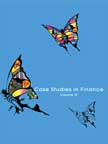A Note on Adjustable Rate and Fixed Rate Mortgage Plans in the US
|
|
ICMR HOME | Case Studies Collection
Case Details:
Case Code : FINC048
Case Length : 14 Pages
Period : 1990-2007
Pub. Date : 2007
Teaching Note :Not Available
Organization : -
Industry : Banking
Countries : US
To download A Note on Adjustable Rate and Fixed Rate Mortgage Plans in the US case study (Case Code:
FINC048) click on the button below, and select the case from the list of available cases:

Price:
For delivery in electronic format: Rs. 300;
For delivery through courier (within India): Rs. 300 + Shipping & Handling Charges extra
» Finance Case
Studies
» Short Case Studies
» View Detailed Pricing Info
» How To Order This Case
» Business Case Studies
» Case Studies by Area
» Case Studies by Industry
» Case Studies by Company

Please note:
This case study was compiled from published sources, and is intended to be used as a basis for class discussion. It is not intended to illustrate either effective or ineffective handling of a management situation. Nor is it a primary information source.
Chat with us

Please leave your feedback

|
|




<< Previous
Excerpts Contd...
Fixed Rate Mortgage
|
A fixed-rate mortgage usually has the same interest rate throughout the life of
the loan. FRMs are most common in 30-year and 15-year terms, but recently more
lenders in the US have begun offering 20-year loans. Traditionally, FRM was the
most popular, due to the following reasons.
• It is easy to plan and budget for a FRM since the interest rate and the amount
to be paid every month are fixed.
• It protects against inflation since the interest rate does not change
throughout the loan period.
• It is comparatively easy to understand how a FRM works.
|

|
• In the long run, the interest rate on an ARM can exceed that of FRM.
• Homeowners can easily budget how much they should keep aside for the mortgage
payment.
However, FRM also has its own disadvantages. They are:
• Since FRM carries a fixed rate of interest, the mortgage lender is likely to
charge a higher interest rate in order to compensate for the risk of increase in
the market rate of interest in the future...
|
|
ARM Vs. FRM
Despite the fact that ARM has many advantages, the
disadvantages associated with it cannot be ignored. Any significant
increase in the benchmark index rate may have a severe impact on the
borrower. Freddie Mac, one of the largest purchasers of mortgage loans
in the US, reported that the national averages for 30 year fixed rate
mortgages rose from 6.18 percent in January 2007 to 6.74 percent in June
2007. While the low interest rate regime may be considered beneficial to
the economy, it also helped create conditions for a downturn in the real
estate industry... |
Exhibits
Exhibit I: Treasury Yield Curve Rates
Exhibit II: 11th District Cost of Funds Index in 2007
Exhibit III: Libor Rates in 2007
Exhibit IV: 12 Month Treasury Average Rate (12 MTA) in 2007
Exhibit V: Wachovia Cost of Savings Index in 2007
Exhibit VI: Prime Rate in 2007
Exhibit VII: National Average Mortgage Rates as of June 22, 2007
Exhibit VIII: Repayment Schedule
|
|










